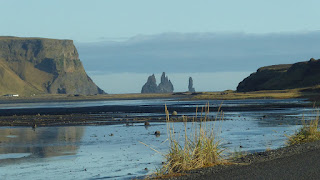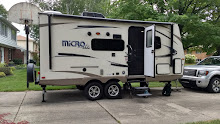Wednesday, October 17: The ads for the Blue Lagoon often show a happy
young lady in the warm waters on a sunny day which happens we believe once a
year. For us photos alone don't do justice to the day's 50 - to 60 mph winds
and temps in the forties. The conditions were due to the hurricane that went
through Ireland. One must shower, nude, under supervision of two
matrons to be sure that NO ONE skips this step and the women’s showers had a
long, slow line, which meant that Kris and Marv had been in and out of the
water (a miserably bone chilling experience when out) several times looking for
us before we made it out. They were basically totally over The Blue Lagoon by
the time we showed up. But Heidi and I had a wonderful time exploring the
silica mud pots to apply to the skin, the sauna, the steam bath, and even the
far pool, which had less than a dozen people in it. We would probably count it
as one of the high points of the trip, while Kris and Marv might have counted
it the lowest of the low. And we found out later that pretty much every town
has its own very popular geothermal public pool, where locals hang out daily
like a sort of coffee shop, that we could have attended at a fraction of the
cost of the Gate 1 bus tour we did for it. Our advice to anyone going to
Iceland is to skip the very expensive Blue Lagoon and find one of those public
pools!!
The Blue Lagoon (Icelandic: Bláa lónið) geothermal spa
is one of the most visited attractions in Iceland. The spa is located in a lava field in Grindavík on the Reykjanes Peninsula, southwestern
Iceland in a location favorable for Geothermal power, and is supplied by water
used in the nearby Svartsengi geothermal power
station. The warm waters are rich in
minerals like silica and sulfur and
bathing in the Blue Lagoon is reputed to help some people suffering from skin
diseases such as psoriasis. The water temperature in
the bathing and swimming area of the lagoon averages 99–102°F. The Blue Lagoon also operates a research and development
facility to help find cures for other skin ailments using the mineral-rich
water. The lagoon is a man-made lagoon which is fed by the water output of the
nearby geothermal power plant Svartsengi and is renewed every two
days. Superheated water is vented from the ground near a lava flow and used to
run turbines that
generate electricity. After going through the turbines, the steam and hot water
passes through a heat exchanger to
provide heat for a municipal water heating system. Then the water is fed into
the lagoon for recreational and medicinal users to bathe in.
 |
| How the Tourism Council wants you to see The Blue Lagoon |
 |
| How it appeared from inside the main building the day we visited. |
 |
| Kris got this one single picture of Marv and me in the lagoon before Marv retreated to the building. |
That
afternoon, we did a free walking tour (donations
accepted) of Reykjavik. Our guide, Sarai, was a high school history teacher who was very
knowledgeable about the history and culture of the country, and fiercely proud to be a
true Viking woman. She had a great
sense of humor and taught us many useful tips, like about the local swimming pools
and that the best place to get somewhat reasonable food is in the Old Harbor
area. Kris and Heidi always recommend
doing these free city walking tours wherever they are offered and now we see why.
They are very informative and less costly than commercial tours.
 |
Iceland's Parliament Building. Note the lack of flags (noticeable on most buildings)
or armed guards. The only armed building in Iceland is the American Embassy. 😕 |
 |
| We met our tour guide (in the yellow jacket) under the statue across from the Parliament Building. |
 |
| The oldest remaining church in Iceland. |
 |
Entering the Old Town of Reykjavik. Most of the old wooden
buildings were wiped out by a huge fire. |
 |
The oldest wooden buildings and warehouses by the harbor were once
dilapidated and mostly abandoned. Now they are the most expensive
and desirable Real Estate in the city! |
 |
| The name plate on this house is dated 1852. |
 |
Part sculpture and part utilitarian, these vertical pipes carry
geothermal water and are a good place to warm ones hands. |
 |
Streets and roofs throughout Reykjavik (and much of Iceland)
are heated by geothermal action and snow removal is never needed. |
 |
| The Prime Minister's home; again, no flags or guards. |
 |
| The hill topped city park beside the Prime Minister's house. |
 |
This impressive statue of Ingólfur Arnarson by famous
architect Einar Jonsson is atop a hill at the center
of a grassy park. Ingolf
was a settler from Norway near 870 and is usually considered the first settler
of Iceland. Thanks to a recent Gay Pride parade, his lips are painted pink to reflect that Iceland is
open to LGBTQ rights. All of Icelandic Pride
activities start from here. |
 |
ÓÞEKKTI EMBÆTTISMAÐURINN
Lækjargata, port
Artist Magnús Tómasson
The Unknown Bureaucrat is a popular favorite, as
it manages to be both humorous and provocative, while truthfully depicting
something that most everyone can relate to, the trivial existence of the
working bee. The block of rock is a perfect metaphor for how everyday life
crushes down on us, while at the same time depicting the narrative of the
faceless official who is only a cog in the wheel, and never a person to most of
us. Even the location is a thoughtful comment on the trivial existence of the
Unknown Bureaucrat, in a closed off back alley. |
 |
Sarai took us by this old Harbor bar, which we returned to after the tour for
its Happy Hour craft beer, which was "only" $6 instead of $12.
|
 |
It had a great atmosphere similar to the Cheers Bar and had a huge stuffed
Boarshead on the wall, making me wonder if that was the name of the bar. |
 |
Here's the Arnarson statue at night. Our tour taught us that coming by him
was a good short cut back to our hotel from the Old Town district. |





































































